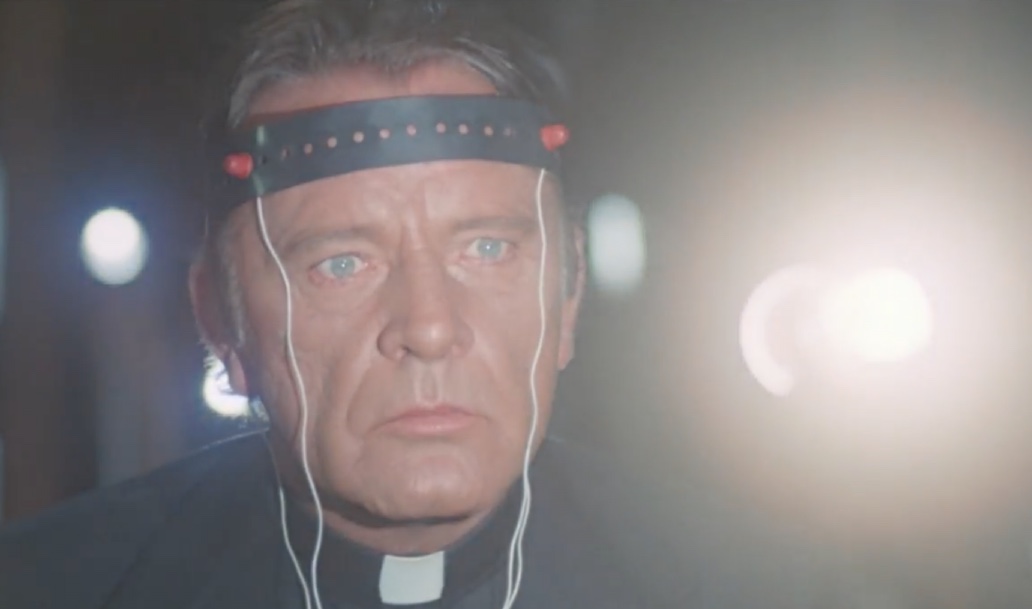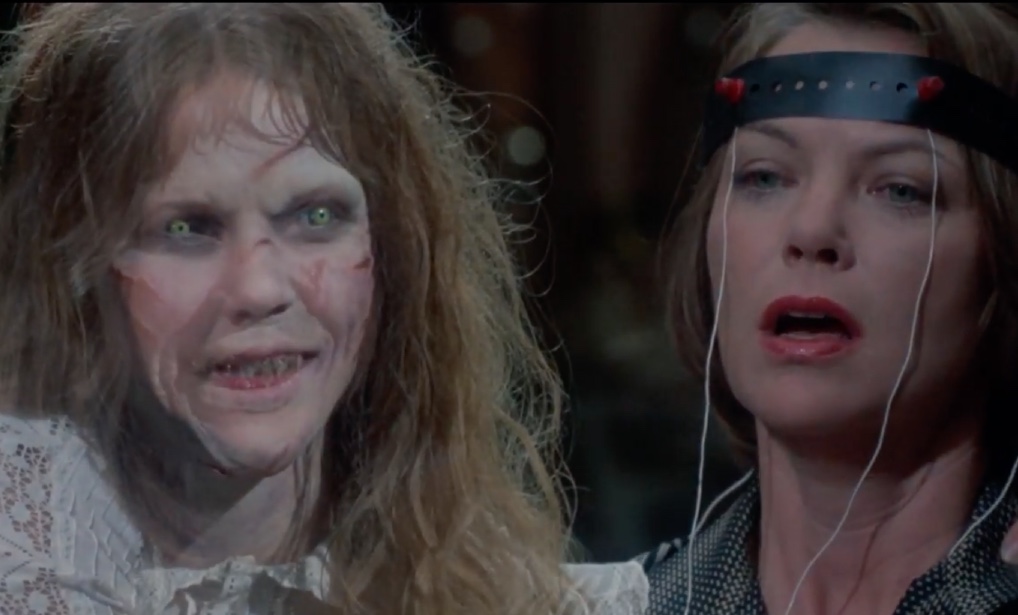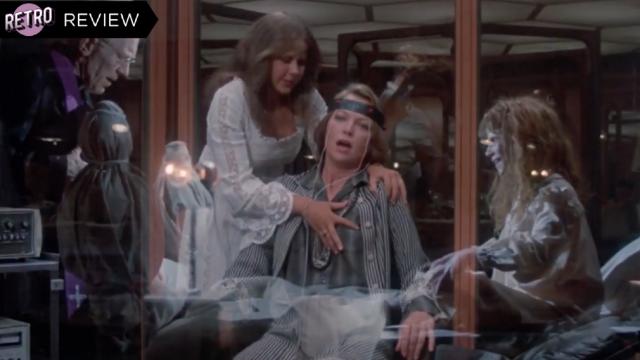The Exorcist is legendary. The Exorcist III is fascinating. The dueling fourth parts of the Exorcist saga are odd enough to be interesting, and the Exorcist TV show was criminally underrated. And then somehow there’s Exorcist II: The Heretic, easily one of the most mystifying horror sequels ever made.
A majestic misfire, it hasn’t earned much cult adoration in the 44 years since its release, which a shame considering how ridiculous it truly is. The Exorcist II arrived four years after William Friedkin’s adaptation of William Peter Blatty’s novel terrified audiences and critics alike — in a good way, raking in box office dollars and winning two Oscars (after being nominated for 10, including Best Picture). Its sequel, which checks back in with Regan MacNeil (Linda Blair) four years after her demonic possession, also proved terrifying, but not in a good way. (In a 2013 interview with HuffPost, Friedkin called Exorcist II “one of the worst films I’ve ever seen. It’s terrible. I find it worse than terrible; I find it disgusting.”)
[referenced id=”1519255″ url=”https://gizmodo.com.au/2020/10/the-exorcist-documentary-leap-of-faith-takes-you-inside-an-iconic-directors-mind-and-process/” thumb=”https://gizmodo.com.au/wp-content/uploads/2020/10/14/tx7slvmekiwgfitjtdcy-e1602621949275-300×149.jpg” title=”The Exorcist Documentary Leap of Faith Takes You Inside an Iconic Director’s Mind and Process” excerpt=”You’ve seen The Exorcist, probably more than once; by now, even the often-repeated stories about its creation are the stuff of Hollywood legend. But there’s always room for more — especially in a new doc that goes straight to the source to dig into one of the most acclaimed horror…”]
On paper, it must’ve seemed like a good idea. Equal parts controversial and sensational, The Exorcist was an acclaimed blockbuster and while the 1970s weren’t quite as sequel-hungry as the world we live in now, Warner Bros.’ decision to bring Satan’s BFF Pazuzu back for another round made sense. With Friedkin, Blatty, and original stars like Ellen Burstyn (Chris MacNeil) and William O’Malley (Father Dyer) refusing or unavailable to return, John Boorman (Deliverance, Zardoz) was hired to direct, with playwright William Goodhart penning the script.
The cast did snag some returnees — Blair as Regan, Max von Sydow as Father Merrin (who appears in flashbacks only, for obvious reasons), and Kitty Winn as Regan’s guardian Sharon — but also some new additions, notably Richard Burton as the conflicted Father Lamont, who reluctantly agrees to investigate Father Merrin’s death on behalf of the Catholic Church; Louise Fletcher (a Burstyn lookalike) as Regan’s therapist, Dr. Gene Tuskin; and James Earl Jones, whose role is too bizarre to succinctly describe. For what it’s worth, the great Ennio Morricone was brought on to create an appropriately unsettling score — and though his hysterical flourishes help the mood edge toward giallo at times, there’s nothing so memorably eerie as the first film’s use of “Tubular Bells.”

So, with all that talent, what could go wrong? How about…everything? With a story that aims to dive into “metaphysical” horror and contrasting acting styles that often make it seem like Burton is performing his own solo show, the unintentional hilarity of The Exorcist II starts early and doesn’t let up. In its New York City scenes, unsubtle set design favours mirrors and windows and reflective surfaces everywhere — including Dr. Tuskin’s office, which is an inexplicably chaotic labyrinth of glass rooms; meanwhile, its Africa scenes are painted with the widest brush of grimy “otherness” as possible.
The dialogue is studded with howlers, though this exchange between Regan and another of Dr. Tuskin’s patients (an autistic girl played by future tragic child star Dana Plato) is maybe my favourite.
Little girl who has literally just spoken aloud for the first time thanks to Regan’s psychic assistance, because Regan has psychic powers now by the way: “What’s wrong with you?”
Regan, matter-of-factly: “I was possessed by a demon. [Sees look of terror on child’s face] Oh, it’s OK. He’s gone!” [Giggles]
Or maybe it’s when Father Lamont insists to Dr. Tuskin, vis-à-vis Regan, “Your machine has scientifically proven that there’s an ancient demon locked within her!” Or perhaps it’s when Jones, playing a character who was possessed by Pazuzu as a child much like Regan was, appears to Lamont in a vision of sorts — dressed in a locust costume, hanging out in a cave, blessed with the ability to manifest oranges and leopards out of his mouth — to tell him, “Pazuzu has brushed you with his wings. You called on Pazuzu to reach me. You have lost faith in your God!”, before beckoning Lamont to prove his faith by walking on a bed of nails. We watch, horrified, as Lamont’s foot is gruesomely impaled before he wakes up in a completely different setting, his loyalties apparently affirmed. Or not? It’s hard to tell since Lamont starts acting Pazuzu-possessed himself not long after.

These quotable gems are hilarious but they also capture the entire thrust of The Exorcist II. The movie fervently wants you to remember “that time in Washington” (as Regan’s possession is casually referred to early in the movie), to the point of including Merrin vs. demon reenactments that pass as Regan’s memories as well as visits to her former home in Georgetown. But it also wants to smear its own woo-woo ideas all over the original Exorcist, which is an effective horror movie precisely because it uses an intimate, deeply personal story to examine some huge themes — good versus evil, faith (or lack thereof), the lingering effects of guilt, the perils of adolescence, etc.
On the other hand, its sequel is a mess of ideas that are at best confusing but at worst come across like self-parody. By way of exposition, or perhaps to ground his methods in something resembling reality, Father Lamont tells Regan — who’s asked him “Do priests believe in ESP?” — about the work of Jesuit priest Pierre Teilhard de Chardin, who “thought that we’d all come together eventually in some sort of mental telepathy, a kind of world-mind in which everybody would share.” Somehow the script sinks its chompers into that idea and uses it to weave a madcap tale that unfolds as a string of WTFuckery.
Take your pick: multiple scenes of astral projection and telepathy, often but not always guided by a beep-boop electronic device; a teenage girl who’s really into drawing and tap-dancing but was once possessed (and also still kinda is) and is also the Chosen One who will save humanity’s hive mind from turning toward Satan; lots of extreme close-up shots of locusts, and just a lot of literal and metaphorical locusts in general; a doctor who insists “let’s stick to science!” as she straps her patient into a “synchronised hypnosis” machine; and an increasingly unhinged priest who defies Church orders — duh, see: the movie title — without a shred of hesitation, and who’s also able to zip back and forth between New York City and Ethiopia with an ease that goes completely unaddressed.

It all leads up to a knee-slapper of a climax in which a plane nearly crashes (and a taxi does crash, right into the gates of the accursed Georgetown house); Father Merrin pipes in from beyond the grave to try to explain a plot that’s long since stopped making sense; poor Sharon sets herself on fire; Lamont rips the heart of a demon (that has transformed itself into a sexy version of 16-year-old Regan, for extra icky spice) out of its chest (in a scream-y, locust-y struggle that goes on for what feels like hours, and during which the house, a set made from what looks like cardboard, physically rips apart); and the real Regan spontaneously does a magic ritual to stop you-know-which malevolent insects from swarming Washington, DC.
It’s kind of perfect that the last lines in the film are a cop saying “Lady, are you OK?” to Dr. Tuskin, who’s standing completely dazed in the rubble outside of Regan’s house after witnessing, well, all of the above. She’s not OK, and neither is anyone who mangled their brain watching the movie that just ended. Obviously, The Exorcist II was never going to duplicate the towering success of its predecessor, but the fact that that it fails on so many cinematic levels makes it kind of a miracle in itself. A weird, exhausting miracle that will leave you wondering what in Pazuzu’s name you just saw. Is it unwatchable, though? Viewing it four-plus decades after its release, it’s nearly campy enough to forgive its pretentiousness, though perhaps not to excuse how much it squandered its potential as a sequel to one of the all-time greats.
Speaking of, there’s a brand-new Exorcist sequel in the works from Blumhouse and Halloween remake director David Gordon Green. Chances are excellent that it won’t resemble The Exorcist II one bit, though the faint stench of a cash grab — do we really, truly need another Exorcist movie? — will linger. Maybe they’ll throw in a locust for good luck.
[referenced id=”1666602″ url=”https://gizmodo.com.au/2021/01/cult-horror-classic-lets-scare-jessica-to-death-is-still-as-bizarre-as-its-title/” thumb=”https://gizmodo.com.au/wp-content/uploads/2021/01/22/fl1m8xcrkaa8camj2bch-300×170.jpg” title=”Cult Horror Classic Let’s Scare Jessica to Death Is Still as Bizarre as Its Title” excerpt=”With a title like Let’s Scare Jessica to Death, you’d forgiven for assuming this low-budget cult movie arrived as part of the post-Friday the 13th wave of 1980s slashers, especially considering its lakeside setting. But it came out in 1971 — and 50 years later it’s still unsettling in ways…”]
